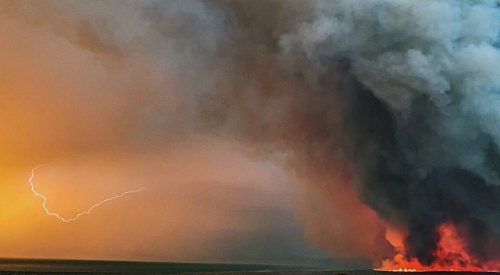
Though 2020 has been untraditional in many ways, Mother Nature isn’t holding back, wreaking havoc and even causing unparalleled devastation, including wildfires and extreme storms in parts of the U.S..
Oregon is battling several wildfires at the moment caused by a heatwave, none of which are a threat to citizens yet, says Timothy Ingalsbee, executive director of Firefighters United for Safety, Ethics and Ecology (FUSEE). He adds that the status of fires changes daily, so it’s difficult to keep up with them and give an overview.
“Many of these fires that are burning are not ecological disasters. They are in very remote country,” he says. He adds that Gov. Kate Brown declared a state of emergency recently, which allows firefighters to access more funding in fighting the fires.
A handful of wildfires — including Beachie Creek, Mosier Creek and the Indian Creek fire — are all currently being fought by firefighters. The Indian Creek fire in eastern Oregon near Vale is the largest right now, burning at 50,000 acres. Ingalsbee adds that though some campgrounds were evacuated, no homes have been.
But the issue in fighting these fires is that they are difficult to reach. In a press release by USDA and the U.S. Forest Service, Type Three Incident Commander Jonah Gladney said that there are no roads so firefighters have to hike in extremely rough terrain to access the fires.
Meanwhile, California is seeing wildfires like never before caused by lightning strikes. Lynette Round is an information officer with Cal Fire, California’s department of forestry and fire protection, and she says that two of their fires make the top ten for the state’s worst wildfires of all time.
“We haven’t seen a fire siege quite like this. Back in 2008 was the last time we’d seen something of this nature,” Round says. The fires have moved quickly through well populated areas, she says. Over 115,000 people have already been evacuated.
Halfway across the country, Cedar Rapids, Iowa, and surrounding cities were hit by a severe hurricane-like storm — called a derecho — that devastated the entire area. With hardly any warning, the storm pulled down power lines, flung trees into houses and ripped roofs off during its 45-minute run.
Cedar Rapids Mayor Brad Hart says based on meteorologist studies, the wind gusts ranged from 80-140 miles per hour, blowing as fast as a Category 4 hurricane. Over 135,000 citizens, essentially Cedar Rapids’ entire population, lost power.
He says trees blocked roads and cell service was out for a few days. The entire community was forced to stew in the aftermath with no way to communicate or get anywhere.
“It’s like science fiction. How could that happen to a modern city to have no power, no way to drive the streets and no cell service?” he says. Since the storm, Hart says that electric companies and the city have been slowly fixing the power and removing trees. Some people have come out to Iowa to volunteer their help in removing trees and limbs. But they still have a long way to go.